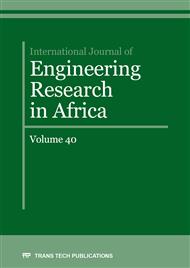[1]
G.A. Akeke, M.E. Ephraim, I.Z.S. Akobo, J.O. Ukpata, Structural Properties of Rice Husk Ash Concrete, International Journal of Engineering and Applied Sciences, 3(3), (2013) 57-62.
Google Scholar
[2]
W.N. Akhionbare, A Comparative Evaluation of the Application of Agro-waste as Construction Material. International Journal of Science and Nature, 4(1), (2013) 141-144.
Google Scholar
[3]
N.G. Alireza, A.R. Suraya, N.A. Farah, A.S. Mohamad, Contribution of Rice Husk Ash to the Properties of Mortar and Concrete: A Review, Journal of American Science, 6(3), (2010) 157-165.
Google Scholar
[4]
ACI Education Bulletin E1-07, Aggregates for Concrete, Developed by Committee E-701, Materials for Concrete Construction, American Concrete Institute (2007).
Google Scholar
[5]
ASTM C494-99, Standard Specification for Chemical Admixtures for Concrete, American Society for Testing and Materials International, 100 Barr Harbor Drive, PO Box C700, West Conshohocken, PA 19428-2959, United States, (1999).
Google Scholar
[6]
ASTM C 618-05, Specifications for Coal Fly Ash and Raw or Calcined Natural Pozzolan for Use in Concrete, American Society for Testing and Materials International, 100 Barr Harbor Drive, PO Box C700, West Conshohocken, PA 19428-2959, United States, (2005).
DOI: 10.1520/c0618-00
Google Scholar
[7]
ASTM C192/C192M-06, Standard Practice for Making and Curing Concrete Test Specimens in the Laboratory, American Society for Testing and Materials International, 100 Barr Harbor Drive, PO Box C700, West Conshohocken, PA 19428-2959, United States, (2006).
Google Scholar
[8]
N. K. Amudhavalli, J. Mathew, Effect of Silica Fume on Strength and Durability Parameters of Concrete, International Journal of Engineering Sciences & Emerging Technologies, 3(1), (2012) 28-35.
Google Scholar
[9]
K.D. Ashish, Effect of Pozzolanas on Fiber Reinforced Concrete, M.Tech Desertation, National Institute of Technology, Rourkela-769008, (2010) pp:1. Retrieved February 19, 2015, from http://ethesis.nitrkl.ac.in/2032/1/FINAL_PROJECT_OF_M_TECH.pdf.
Google Scholar
[10]
BS EN 12390-3, Testing Hardened Concrete - Compressive Strength of Test Specimens, British Standards, BSI Group Headquarters 389 Chiswick High Road, London, W4 4AL, UK, Standards Policy and Strategy Committee, (2009).
Google Scholar
[11]
BS EN 12390-7, Testing Hardened Concrete - Density of Hardened Concrete, British Standards, BSI Group Headquarters 389 Chiswick High Road, London, W4 4AL, UK, Standards Policy and Strategy Committee, (2009).
Google Scholar
[12]
BS 882, Specification for Aggregates from Natural Sources for Concrete, British Standards, BSI Group Headquarters 389 Chiswick High Road, London, W4 4AL, UK, Standards Policy and Strategy Committee, (1992), (Amended 6th March, 2002).
Google Scholar
[13]
BS 8110 Part 2, Structural Use of Concrete. Code of Practice for Design and Construction, British Standards, BSI Group Headquarters 389 Chiswick High Road, London, W4 4AL, UK, Standards Policy and Strategy Committee, (1985), p.7/1.
Google Scholar
[14]
CP, Code of Practice for Structural Use of Concrete, February 2013. The Government of the Hong Kong Special Administrative Region, (2013), p.14.
Google Scholar
[15]
CS1, The Government Construction Standard, Testing Concrete, Volume 2 of 2, September 2010, of the Hong Kong Special Administrative Region, (2010), pp.14-28.
Google Scholar
[16]
M.E. Ephraim, G.A. Akeke, J.O. Ukpata, Compressive Strength of Concrete with Rice Husk Ash as Partial Replacement of Ordinary Portland cement, Scholarly Journal of Engineering Research, 1(2), (2012) 32-36.
Google Scholar
[17]
L.O. Ettu, N.N. Osadebe, M.S.W. Mbajiorgu, Suitability of Nigerian Agricultural By - Products as Cement Replacement for Concrete Making, International Journal of Modern Engineering Research (IJMER), 3(2), (2013) 1180-1185.
Google Scholar
[18]
F. J. Faleye, S. Ogunnubi, O. Olaofe, Chemical and Physical Analyses of Selected Cement Samples in Nigerian Market. Bangladesh Journal of scientific And Industrial research, 44(1), (2009) 41-50.
DOI: 10.3329/bjsir.v44i1.2712
Google Scholar
[19]
A.H. Ghassan, M. Hilmi, Study on Properties of Rice Husk Ash and Its Use as Cement Replacement Material, Materials Research, 13(2), (2010) 185-190.
DOI: 10.1590/s1516-14392010000200011
Google Scholar
[20]
R. Jayanti, R.K. Yadav, R. Chandak, The Effect of Rice Husk Ash Used as Supplementary Cementing Material on Strength of Mortar. International Journal of Engineering Research and Applications (IJERA), 3(3) (2013) 133 – 136.
Google Scholar
[21]
S.I. Khassaf, A.T. Jasim, F.K. Mahdi, Investigation the Properties of Concrete Containing Rice Husk Ash to Reduction the Seepage in Canals. International Journal of Scientific & Technology Research, 3(4), (2014) 348-354.
Google Scholar
[22]
B. Nabil, F. Simon, Use of Fly Ash and Slag in Concrete: A Best Practice Guide. Sponsored by Government of Canada Action Plan 2000 on Climate Change, (2005).
Google Scholar
[23]
A.M. Neville, Properties of concrete, 5th Edition. Pearson Education Limited, Edinburgh Gate, Harlow, Essex CM20 2JE, England, (2011).
Google Scholar
[24]
I.O. Obilade, Use of Rice Husk Ash as Partial Replacement for Cement in Concrete. International Journal of Engineering and Applied Sciences, 5(4), (2014) 11-16.
Google Scholar
[25]
O. Olawale, F.A. Oyawale, Characterization of Rice Husk via Atomic Absorption Spectrophotometer for Optimal Silica Production. International Journal of Science and Technology, 2(4), (2012) 210-213.
Google Scholar
[26]
A.M. Pande, S.G. Makarande, Effect of Rice Husk Ash on Concrete. International Journal of Engineering Research and Applications (IJERA), 3(1), (2013) 1718-1723.
Google Scholar
[27]
SP 23 Handbook on Concrete Mixes, Based on Indian Standards, Bureau of Indian Standards, New Delhi 110002, (1982), 6th Reprint, November 2001, p.22.
Google Scholar


